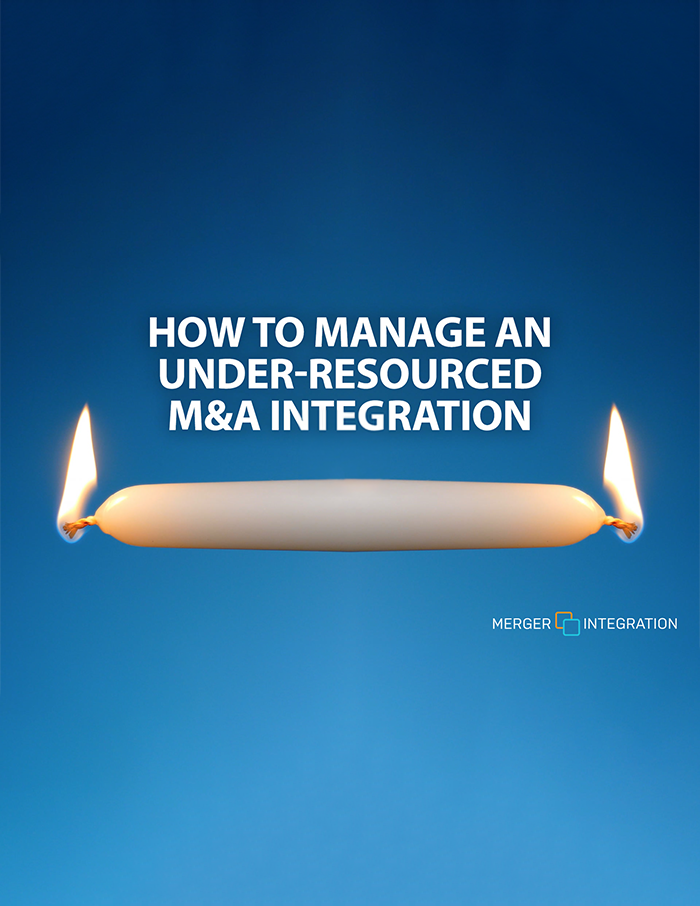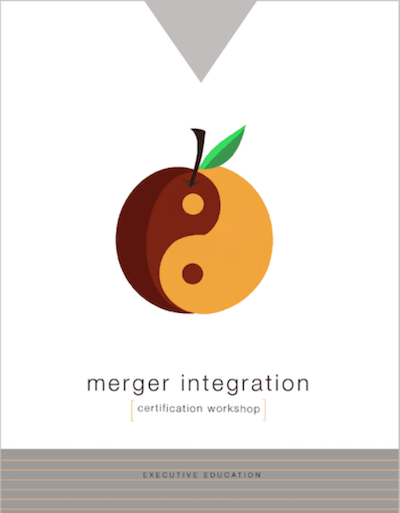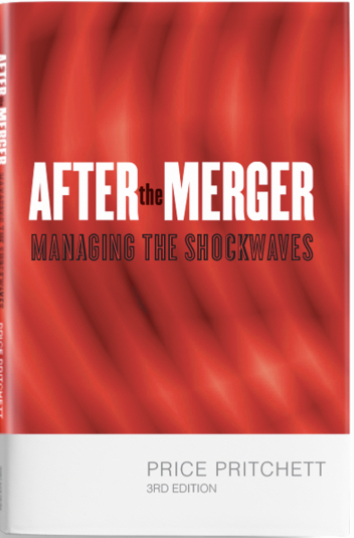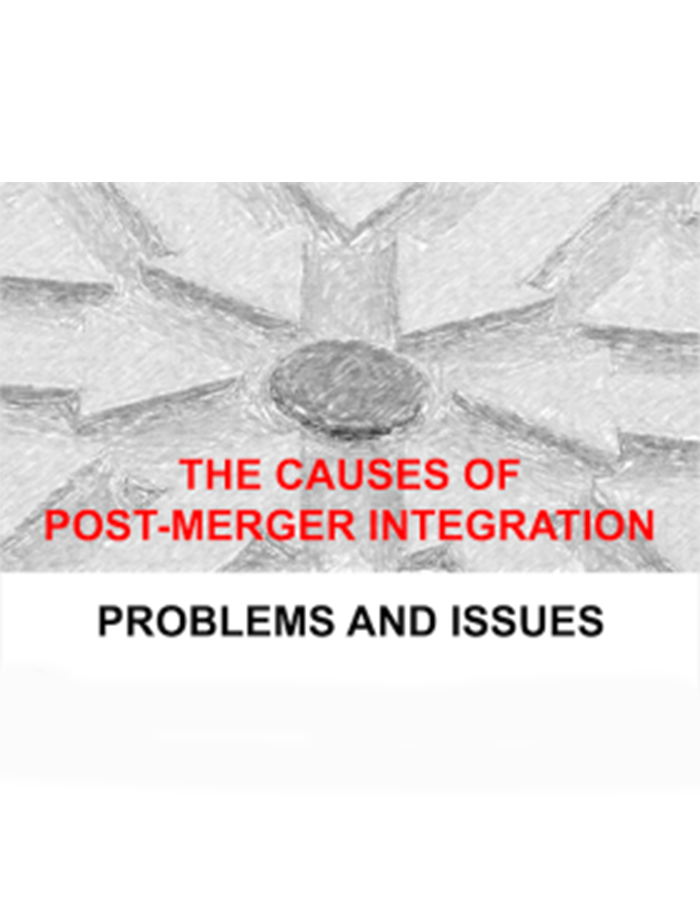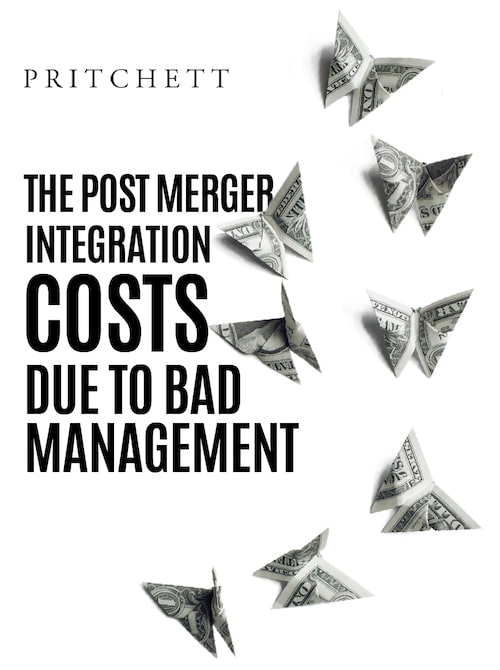Answers to Post-Merger FAQS on:
Best Practices
Communication
Day 1
M&A Integration Teams
M&A Integration Plans
Acquisition Integration
Culture
Managing People
Post-Merger Exam
Based on Answers to FAQs
How can you mitigate post-merger integration risks if your integration is under-resourced?
What are factors will impact your M&A integration risks?
- Amount of expected consolidation or integration
- Alignment/compatibility of the two organizations’ business strategies
- Extent to which the two organizations have been competitors
- Financial pressures confronting the new merged organization
- Level of confusion or ambiguity regarding the merged organization’s power structure
- Geographical distance between the merging organizations
- Overall market conditions confronting the merged organization
- Cultural differences between the two organizations
- Amount of expertise the organization has in merger integration
- Other major demands on the organization concurrent with the integration
- Degree of resistance to the merger within the organization
When should you consider hiring M&A integration consultants?
When these criteria are met, the risk levels are so high that hiring consultants should be seriously considered:
- The acquirer's employees are already carrying a heavy workload
- The acquirer does not have a have a streamlined, proven integration methodology to follow
- The acquirer lacks integration experience on deals like its next one
- The stakes on the next acquisition are higher than they have ever been before or the frequency of acquisitions is increasing
Why are “merger of equals” often riskier than other types of deals?
When companies announce their deal is a “merger of equals,” it creates confusion as to who is calling the shots. Also, the attempt to be equal and therefore build a consensus on issues slows down decision-making and momentum. In reality, there is no such thing as a "merger of equals" because there is always someone in charge who has final say. Power is never distributed equally.
What is gun jumping?
What is usually the worst managed aspect of integrations?
Communications. It is commonplace for an acquirer to assume that it has done a satisfactory job of communicating to people who’s in charge, who reports to whom, and what’s expected of everyone. But people constantly complain about confusing lines of authority and an ill-defined power structure. Employees feel they are operating in too much of a fog. The situation breeds frustration and tangled relationships, with the result being a blow to employee motivation.
What are common post-merger integration risks?
What risks are exacerbated by poor communications during an M&A integration?
- Cultural clash: Some cultural friction is to be expected but poor communication makes it much worse.
- Customer attrition: Customers have a good excuse to defect when they are not kept apprised of what is going on.
- Rogue planning efforts: Employees kept in the dark will start doing their own “integration activities” that can be detrimental to the business.
- Stalled productivity: Employees lacking information, including about their own situation, may delay decisions and stall a company’s productivity.
- Unexpected costs: Decisions made without accurate information are more likely to be costly.
- Poor morale: A result from any of the above.
Why is integrating later usually riskier than integrating sooner?
If you plan to integrate at some point in time, you probably shouldn’t procrastinate. Waiting to integrate is sort of like delaying surgery—it doesn’t eliminate the dread or resolve the problem. Sure, there’s less immediate pain, but people have to deal with uncertainty for a much longer period of time. So problems fester, and the fear of change is like a low-grade fever that weakens operating effectiveness.
How can you tell when risks are starting to turn into major issues?
- Key people are leaving
- You are not hitting the numbers
- Top management is holed up in the executive bunker
- Communication starts drying up
- People are focused on internal politics and issues instead of customers
- You’re losing clients
- There’s confusion regarding corporate strategy and direction
- The integration process is sluggish and losing momentum
- Management is scattered due to a poor sense of priorities
- Competitors are closing in
What is usually the most dangerous phase of M&A integration?
The 3-month period starting 100 days after close. This is when executives drop their facades and politeness fades. The thinly veiled issues and problems that were previously glossed over have to be dealt with, and the “nice” behavior exhibited right after close gives way to open disagreement, strained relations, and power struggles. Nerves are on edge. Tempers flare. Cliques and alliances form. The leader’s authority may be challenged. With so much energy and attention devoted to infighting, the team’s performance deteriorates and some executives seriously consider leaving. This is the shakiest point in the integration process and senior managers usually do not see it coming.
What are the signs a merger integration is being mismanaged?
You will see several of these major problems and the costs that accompany them:
- Lost Talent: Bailing out by managers and executives is one of the first signals that a merger is being run poorly.
- Productivity Decline: When the merger is marked by weak leadership, poor communication, and a lack of decision making, productivity takes a beating.
- Weakened Competitive Position: Employees who are poorly led show little determination. They lose their fighting spirit. Sales drop off. Customer loyalty deteriorates. Competitors smell blood and rush in for the kill.
- Disillusioned workforce: Employees often become preoccupied with their own problems and demoralized about their work when management does not address their concerns.
- Miscast Managers: If important management and executive slots are filled by misfits, the chances for success are dismal.
What are six post-merger integration management mistakes?
1. Lack of a clearly defined Integration Manager.
Make sure one person is put in charge of the integration effort. Assigning individual accountability and responsibility is one of the best ways to make sure things get done.
2. Failure to execute against plan.
Transition teams often find it easier to develop a plan than execute one. The program for action should not be so complicated that it cannot be carried out. The role of the Integration Management Office is to ensure that the plan is manageable and that the integration teams do not become sidetracked.
3. Declaring victory on the 20-yard line.
Avoid the temptation to proclaim that the integration is over just because some important, top-level issues have been settled.
4. Skimping on the investment in the integration effort.
Companies often invest heavily in due diligence, then get remarkably stingy in terms of their willingness to spend on the integration effort.
5. Presuming that all people are at the same point.
Senior management typically spends months planning a merger or acquisition. Invariably, they are way ahead of the rest of the people in terms of having adjusted to the situation. They’ve had access to information, time to wrestle with the issues, and—more likely than not—already have closure on how they personally will be affected by the deal. Other folks will be lagging far behind.
6. Leaving too much on the table.
Usually more juice can be squeezed out of the merger.
What guidelines should be followed to prevent gun jumping prior to close?
- No exercise of control over the other company
- No exchange of competitively sensitive information
- Operate as separate entities until the transaction closes
- No joint pricing, promotions, expansion plans (or influencing each other on these)
- No coordination on competitive practices, decisions, or strategies
- No participation in or influence over each other’s day-to-day operations
- No joint decision-making on purchases or dispositions
- AA employees cannot act on behalf of BB employees, or vice versa
- No coordination on sales, purchasing, or contracts with suppliers or vendors
- No division of customers or markets between the companies
- No implementation of integration plans prior to closing
- No broad unfettered access to each other’s systems (email, reports, etc.)
- No access to office space or sales, marketing, or operational personnel

